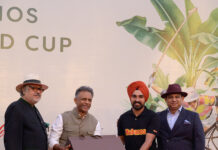By: Dr Srabani Basu
Associate Professor, Department of Literature & Languages
Easwari School of Liberal Arts, SRM University AP, Amaravati.
How ancient mythology shapes modern management, mindfulness, and meaning in leadership
ॐ या देवी सर्वभूतेषु शक्तिरूपेण संस्थिता। नमस्तस्यै नमस्तस्यै नमस्तस्यै नमो नमः॥
(O Devi, who abides in all beings as the embodiment of power, to You, I bow again and again.)
When the world descended into chaos and the demon Mahishasura threatened the balance of creation, the gods did not send one of their own to fight him. They combined their energies to create Durga, a radiant synthesis of all divine strengths. From her ten hands arose ten weapons, each one a symbol of an inner resource.
Yet there was another hand behind those weapons- Vishwakarma, the celestial architect, who forged them with precision. Durga embodied energy; Vishwakarma gave it structure. Together, they reveal a leadership model that is at once timeless and startlingly modern: power is potential, but craftsmanship makes it purposeful.
The ten hands were a symbolic representation of power. In Hindu iconography, Durga’s ten hands stretch in all directions representing the mastery of space, time, and possibility. But for a leader, these hands can be read as ten competencies or resources to wield in moments of chaos, uncertainty, or change.
1. The Trident (Trishul) – Shiva’s gift, crafted by Vishwakarma. Symbolises the triad of creation, preservation, and destruction or in leadership terms, the ability to initiate, sustain, and terminate projects with discernment. A wise leader knows when to start, when to nurture, and when to end.
2. The Chakra (Sudarshan) – Vishnu’s gift, perfected by Vishwakarma. It spins endlessly, a reminder of time and motion. Leaders who understand cycles of markets, moods, or morale adapt rather than resist. Agility, not aggression, ensures survival.
3. The Conch (Shankha) – Varuna’s gift. It resonates with the sound “Om,” the vibration of creation. In leadership, this is communication, the power to align teams through sound, story, and shared purpose.
4. The Bow and Arrow – Gifts of Vayu and Surya. Precision and focus in balance. The bow is tension, the arrow is direction. Leadership demands both the patience to draw back and the vision to aim true.
5. The Thunderbolt (Vajra) – Indra’s weapon, shaped by Vishwakarma. It strikes with clarity. Symbolically, it is integrity and the courage to take decisive action, even when the storm rages.
6. The Sword (Khadga) – Kala’s gift. Represents knowledge that cuts through confusion. Contemporary leaders must wield the sword of critical thinking, slicing through noise and bias to see what truly matters.
7. The Spear (Shakti) – Agni’s gift. Fire turned into focus. The spear is conviction or the ability to pursue goals with purpose, without scattering energy in multiple directions.
8. The Mace (Gada) – Kubera’s gift. Itsymbolizes grounded strength, the kind that comes from discipline, not dominance. It is the power of consistency and credibility.
9. The Lotus (Padma) – Brahma’s gift. It blooms in the mud yet remains unstained which is the emblem of emotional intelligence. True leadership is graceful under pressure, rooted yet radiant.
10. The Shield/Snake – Again a gift from Shivarepresents protection and awareness. Leaders must defend not only their people but also their principles ensuring psychological safety, trust, and ethical boundaries.
It is interesting to note that Vishwakarma is the craftsman behind the power of the goddess. While the gods endowed Durga with divine energy, it was Vishwakarma who forged her weapons, armour, and ornaments. His craftsmanship transformed abstract divinity into tangible impact.
That makes Vishwakarma the first design-thinking engineer of mythology, the one who turned intent into instrument. He reminds us that skill and structure are as sacred as inspiration.
In the leadership context, Vishwakarma embodies operational excellence which is the art of turning ideas into systems. If Durga is the visionary leader who inspires transformation, Vishwakarma is the strategist who builds the framework for it to succeed.
Together they illustrate a universal truth: Leadership is not just the possession of power; it is the precision of applying it.
The lessons that we can learn in leadership from the forge are:
1. Build Before You Battle. Vishwakarma did not wait for the war to start; he prepared the weapons in advance. The best leaders invest in capability before crisis: training, mentoring, and system design are their silent arsenals.
2. Precision Over Power. The Trishul, the Vajra, the Chakra, each is defined by precision. In an era of noise, accuracy is authority. Leaders win not by shouting loudest but by striking truest.
3. Design Thinking as Devotion. Vishwakarma Puja, still celebrated across workshops and factories, is a festival of mindful creation. Every tool, from a pen to a laptop, is worshipped. The lesson: treat your instruments: skills, processes, technologies with reverence. Excellence begins with respect for craft.
4. Integration, Not Isolation. Each weapon alone can wound, but together they protect. Modern leadership demands integration of empathy with efficiency, profit with purpose, personal growth with collective good.
5. Power that Protects, Not Destroys. Durga’s victory was not conquest but restoration of balance. The greatest leaders are those who protect ecosystems- cultural, emotional, environmental, not merely expand empires.
6. Letting Go After Victory. On Dashami, Durga returns to Kailash, reminding us that leadership is transient. Roles change, teams evolve, glory fades and what remains is legacy. True power lies in creating structures that outlast the self.
At its core, the story of Durga and Vishwakarma is not a tale of gods but of the human psyche. Durga lives in the amygdala, the fierce protector, the motivator. Vishwakarma resides in the prefrontal cortex, the planner, the designer. True leadership happens when the two integrate: when instinct meets intelligence.
That inner dialogue is what turns reaction into response, power into purpose, and emotion into excellence.
Because true leadership is not about commanding the world. It is about crafting it with clarity, courage, and compassion.
















